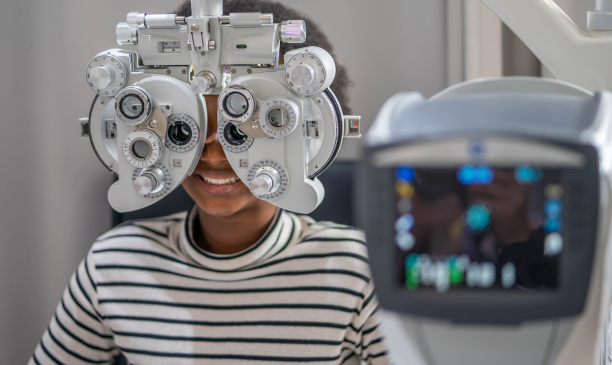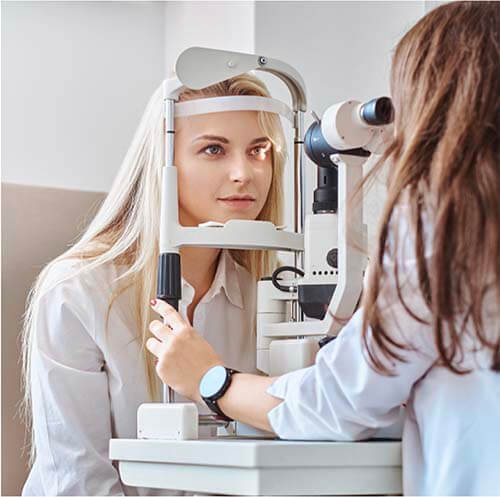Compassionate Eye Doctor: Expert Care for Riverside Residents
Compassionate Eye Doctor: Expert Care for Riverside Residents
Blog Article
The Comprehensive Eye Exam: What to Anticipate During Your Visit to the Eye Doctor
A see to the eye medical professional for an extensive eye test is more than a regular exam; it is an essential action in protecting your visual health and wellness. From the preliminary discussion of your medical history to the precision of the aesthetic skill examination, each part of the examination serves a specific function. What precisely occurs during the eye health analysis, and exactly how does it influence the prescription process? Understanding these components is essential for those that want to keep optimum vision. As we check out each component, the value of follow-up referrals will also end up being clear.
First Assessment
The initial examination during an eye test acts as a crucial structure for understanding an individual's visual wellness needs. This stage sets the tone for the entire evaluation process, allowing the eye doctor to collect important information about the client's medical history, way of life, and certain vision problems. By meticulously assessing any type of pre-existing conditions, medications, or previous surgeries, the eye treatment professional can customize the examination to address specific requirements properly.

Additionally, the initial examination is a possibility for patients to articulate any questions or issues, fostering a collaborative connection with their doctor. This communication not only ensures that the patient feels educated and comfortable but additionally empowers them to take part proactively in their eye health monitoring. Jointly, these conversations allow the optometrist to design an individualized assessment plan, ensuring optimum care and accurate medical diagnosis.
Visual Skill Examination
Beginning the core parts of an eye exam, the visual skill examination is developed to assess the sharpness and quality of a patient's vision. This vital evaluation assists figure out exactly how well a person can discern letters or icons at a standardized range, commonly using a Snellen chart (Optometrist Riverside). The chart makes up rows of letters that lower in dimension inside out, with the patient placed at a popular range of 20 feet
Throughout the examination, the person is asked to cover one eye and review out loud the smallest line of letters they can see clearly. This process is duplicated for the other eye. The outcomes are taped as a portion, with 20/20 vision suggesting regular aesthetic skill-- where the individual can see at 20 feet what a person with regular vision can see at that distance.
The visual acuity test likewise determines potential refractive mistakes such as myopia, hyperopia, or astigmatism, which could necessitate restorative lenses. By developing a standard of aesthetic performance, the examination is a crucial analysis device that helps the eye treatment professional in establishing an appropriate therapy plan customized to the client's unique aesthetic needs.
Eye Wellness Analysis
Complying with the aesthetic skill test, a thorough eye health evaluation is performed to make certain the total wellness of the eyes. This essential section of the eye test entails a thorough evaluation of both the interior and external frameworks of the eye.
Via the use of ophthalmoscopy or fundus photography, the retina, optic nerve, and blood vessels are diligently evaluated. In numerous cases, student extension is done to enhance exposure of the interior eye structures, although this may result in momentary light level of sensitivity for the individual.
Additionally, intraocular pressure is determined to screen for glaucoma risk. This is generally done using tonometry, which can discover elevated pressure degrees that might recommend possible damage to the optic nerve. Jointly, these assessments create a thorough evaluation to maintain ocular health.
Refraction and Prescription
Refraction is an advanced procedure conducted by eye treatment professionals to identify the specific lens power needed to deal with refractive mistakes such as myopia, presbyopia, astigmatism, and hyperopia. The goal of this procedure is to examine how light bends as it passes via the eye, allowing the expert to establish whether restorative lenses are essential for enhanced aesthetic acuity.
Throughout the refraction process, the person Find Out More is asked to look via a phoropter, a device that contains numerous lenses. The expert will methodically transform these lenses and ask the client to compare quality between alternatives up until the best feasible vision is accomplished. This procedure is crucial in crafting an accurate prescription that defines the ideal lens power for eyeglasses or get in touch with lenses.
The prescription obtained from this procedure not just optimizes vision but also serves as a foundation for choosing ideal rehabilitative eyeglasses. It is important to ensure that prescriptions are regularly upgraded, as adjustments in vision can take place gradually, stressing the value of regular eye evaluations. This careful focus to information assists preserve clear, comfy vision in day-to-day life.
Follow-Up Recommendations

Throughout a follow-up visit, the eye physician will certainly carry out a series of examinations to review visual acuity and look for any kind of changes in vision that may require an update to the prescription. In addition, the follow-up provides a chance to talk about any discomfort or issues experienced with existing eyewear. Modifications can be made to ensure convenience and efficacy, whether via lens adjustment or framework adjustments.
For clients with ongoing conditions such as glaucoma, diabetes-related eye problems, or macular degeneration, more frequent follow-ups may be essential. These consultations are essential for managing and potentially slowing down the development of eye condition. Sticking to these referrals can dramatically contribute to maintaining aesthetic wellness and avoiding long-lasting issues.
Verdict
The thorough eye examination is a vital process for preserving aesthetic health and wellness, incorporating a comprehensive assessment of case history and vision worries. Secret parts consist of the aesthetic acuity test, which examines eyesight clarity, and the eye health and wellness evaluation, which examines the overall condition of the eyes. Refraction tests assist determine the precise lens prescription essential for optimal vision correction. Follow-up recommendations offer assistance for continuous eye care, making sure that any prospective problems are attended to without delay and properly.
A check out to the eye physician for a thorough eye exam is even more than a routine examination; it is an essential step in protecting your visual health.Kicking off the core elements of an eye examination, the visual skill test is made to examine the sharpness and clarity of web link a client's vision.Adhering useful content to the visual acuity examination, an extensive eye wellness evaluation is conducted to guarantee the total well-being of the eyes. These brows through permit the eye care specialist to monitor adjustments in vision, update prescriptions, and assess the overall health and wellness of the eyes. Key parts consist of the visual skill examination, which assesses sight clarity, and the eye health and wellness evaluation, which examines the overall problem of the eyes.
Report this page